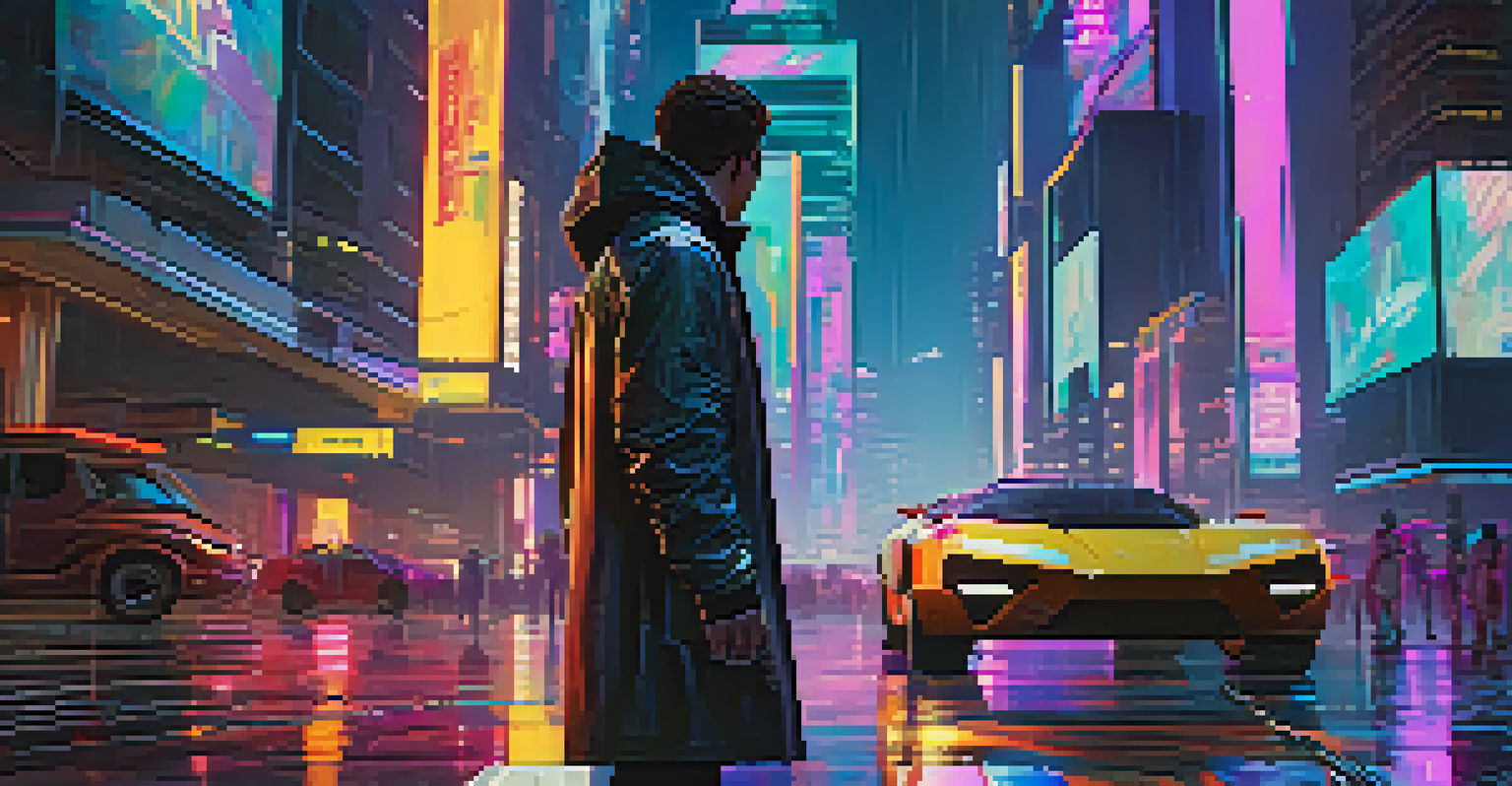The Rise of Cinematic Games: A Hollywood Perspective

The Evolution of Video Games into Cinematic Experiences
Over the past few decades, video games have transformed from simple, pixelated adventures into immersive experiences that rival Hollywood films. This evolution is largely attributed to advancements in technology, allowing for more complex narratives and stunning graphics. As developers harness these tools, storytelling in games has become a focal point, engaging players in ways that were previously unimaginable.
Video games are the most immersive storytelling medium ever created.
Consider titles like 'The Last of Us' or 'God of War,' which not only feature intricate plots but also deliver emotional depth akin to cinematic masterpieces. These games invite players to explore rich worlds and make decisions that impact the story, creating a unique narrative experience. By integrating cinematic techniques such as voice acting, motion capture, and elaborate set designs, developers are crafting stories that resonate on a personal level.
This shift reflects a broader trend: as audiences become more discerning, the demand for high-quality storytelling in all forms of media increases. Gamers today expect narratives that challenge them emotionally and intellectually, pushing developers to raise the bar continuously. This intersection of gaming and cinema has opened new avenues for creativity, leading to a renaissance in interactive storytelling.
Hollywood's Influence on Game Development
Hollywood has always been a trendsetter in storytelling, and its influence on game development is undeniable. Collaborations between game developers and filmmakers have become more common, merging the strengths of both industries to produce blockbuster titles. For instance, games like 'Uncharted' have drawn inspiration from action-adventure films, resulting in gripping narratives that keep players on the edge of their seats.

Moreover, the incorporation of renowned actors and directors into game projects elevates the production value and creates buzz around new releases. With familiar voices and faces, players feel a deeper connection to the story and characters. This synergy not only enhances the gaming experience but also helps bridge the gap between the two entertainment mediums.
Gaming's Cinematic Evolution
Video games have evolved into immersive storytelling experiences, rivaling the emotional depth of films.
As Hollywood continues to explore the gaming landscape, we see a trend towards creating games that mirror cinematic experiences. This fusion is likely to expand, providing gamers with more opportunities to engage with their favorite film franchises in interactive ways. It's an exciting time where the lines between gaming and cinema blur, promising a future filled with innovative storytelling.
The Rise of Interactive Storytelling
Interactive storytelling is a cornerstone of cinematic games, allowing players to influence the narrative's direction. Unlike traditional films, where viewers passively consume content, games invite players to become active participants in the story. This unique format encourages emotional investment, as players face choices that can alter outcomes, making each playthrough a personal journey.
The future of storytelling is not just in how you tell a story, but in how you invite the audience to participate in it.
Take 'Detroit: Become Human' as an example, where players navigate complex moral dilemmas that reflect real-world issues. Each decision leads to different paths and endings, creating a sense of ownership over the narrative. This level of engagement resonates deeply with players, as they see the consequences of their choices unfold in real-time.
As game developers continue to innovate in this space, interactive storytelling will likely become even more sophisticated. With advancements in artificial intelligence and branching narratives, the potential for creating deeply immersive experiences is vast. Players not only enjoy a story but also contribute to its evolution, making each experience unique and memorable.
The Role of Technology in Cinematic Games
Technology plays a pivotal role in the rise of cinematic games, enabling developers to create visually stunning and narratively rich experiences. High-definition graphics, realistic physics, and advanced animation techniques have transformed how stories are told in games. Players can now traverse breathtaking landscapes and interact with lifelike characters, enhancing their emotional connection to the story.
Furthermore, innovations like virtual reality (VR) are pushing the boundaries of immersion, allowing players to step directly into the game world. Imagine experiencing a gripping narrative while feeling as if you're truly part of the action. This level of engagement can evoke powerful emotions, making the storyline even more impactful.
Hollywood's Impact on Games
Collaborations between game developers and filmmakers enhance narrative quality and engage players more deeply.
As technology continues to evolve, we can expect even more groundbreaking developments in the gaming industry. With tools like motion capture and real-time rendering becoming more accessible, the potential for creating cinematic experiences that rival blockbuster films is limitless. The future of gaming looks bright, with technology leading the charge toward richer narratives.
The Cultural Impact of Cinematic Games
Cinematic games have begun to shape culture in ways previously reserved for films and literature. They offer unique narratives that often explore complex themes such as morality, identity, and societal issues. As players engage with these stories, they are not just entertained; they are also prompted to reflect on real-world topics, making gaming a powerful medium for cultural discourse.
For example, titles like 'Life is Strange' tackle teenage struggles and mental health, resonating deeply with players and sparking conversations beyond the screen. This ability to connect on a personal level sets cinematic games apart, allowing them to leave a lasting impact on society. Players often share their experiences and insights, creating a community around these narratives.
As the popularity of cinematic games grows, so does their influence on popular culture. They are shaping how stories are told across mediums, inspiring filmmakers and writers alike. By addressing relatable themes and experiences, games are carving out a significant space in the cultural landscape, one that continues to expand as more people embrace interactive storytelling.
Challenges in Merging Gaming and Cinema
While the blending of gaming and cinema holds great promise, it is not without challenges. One significant hurdle is ensuring that gameplay mechanics do not detract from the narrative experience. Developers must strike a delicate balance between providing engaging gameplay and delivering a compelling story; otherwise, one may overshadow the other.
Additionally, there is the challenge of pacing. In film, pacing is meticulously crafted to maintain viewer interest, while games require a different approach that allows for player agency. This difference can lead to disjointed experiences if not handled thoughtfully. Games need to find ways to maintain narrative tension while allowing players the freedom to explore.
Challenges in Blending Mediums
Balancing engaging gameplay with compelling narratives presents challenges that developers must navigate carefully.
Lastly, there's the risk of alienating traditional gamers who favor gameplay over story. It’s essential for developers to cater to diverse preferences, ensuring that both storytelling and gameplay shine. The path to merging these two worlds is intricate, but overcoming these challenges can lead to groundbreaking innovations in interactive entertainment.
The Future of Cinematic Games in Entertainment
The future of cinematic games seems bright, with endless possibilities on the horizon. As technology continues to advance, we can expect even more immersive and engaging narratives that push the boundaries of storytelling. Innovations like cloud gaming and cross-platform play will also enable a broader audience to access these experiences, democratizing gaming.
Moreover, as Hollywood continues to embrace gaming, we may see an increase in adaptations of popular films into video games and vice versa. This cross-pollination could lead to new, exciting projects that captivate audiences across both industries. Imagine playing through your favorite movie's storyline with interactive elements that allow for a different perspective.

Ultimately, the convergence of cinematic experiences and gaming will continue to evolve, creating a rich tapestry of storytelling. As creators from both worlds collaborate, we can anticipate an exciting future where narrative depth and interactive engagement intertwine seamlessly, offering players unprecedented experiences that will redefine entertainment.